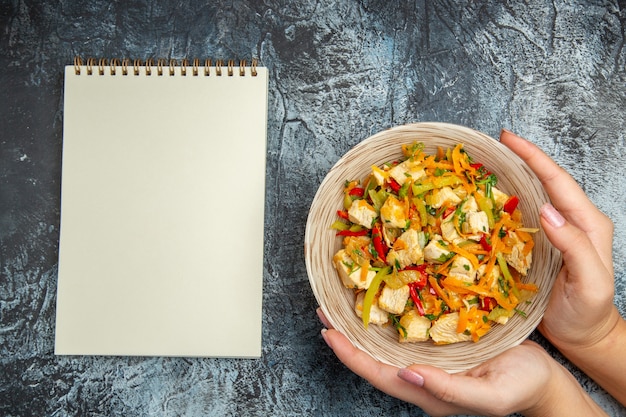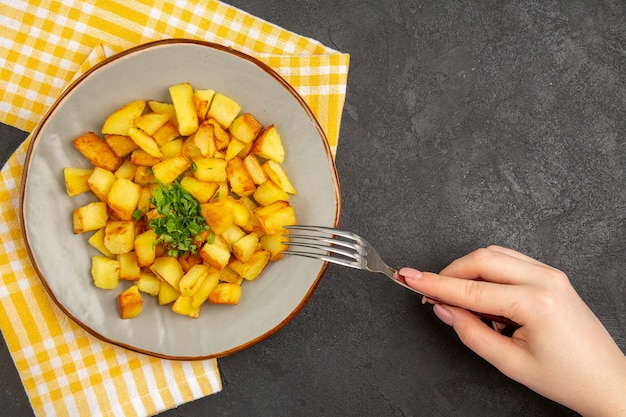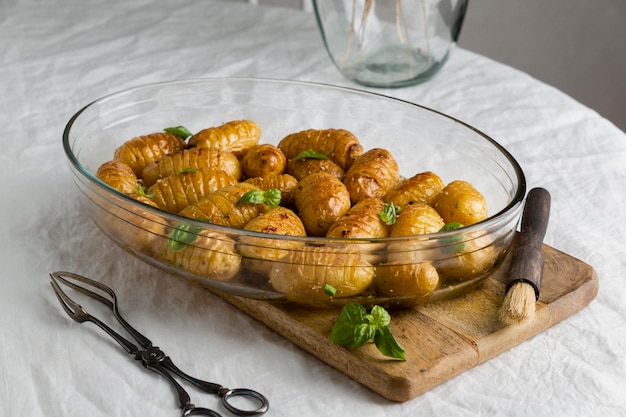Let's face it, potato salad is a classic for a reason. It's versatile, comforting, and always a crowd-pleaser. But have you ever been disappointed by a potato salad that was mushy, bland, or just plain boring? I have! That's why I'm sharing my secrets to achieving the perfect potato salad potatoes, the foundation of any truly delicious salad. It's all about choosing the right potatoes, prepping them properly, and mastering the cooking technique – all of which I'll guide you through step by step.
Part 1: Choosing the Right Potatoes: The Foundation of a Great Salad

The first rule of thumb for perfect potato salad is to start with the right potatoes. Not all potatoes are created equal, and some are simply better suited for this dish than others. This is where understanding the differences between waxy and starchy potatoes comes into play.
1.1: Waxy vs. Starchy Potatoes: A Crucial Distinction
Think of waxy potatoes as the superheroes of potato salad. They’re known for their firm texture, which holds up beautifully during cooking, preventing them from turning into mush. This is crucial for a salad where you want each potato bite to remain intact and flavorful. Examples of waxy potatoes include new potatoes, red potatoes, and Yukon Golds.
On the other hand, starchy potatoes, like russet potatoes, are ideal for baking, mashing, or roasting. Their starch content makes them break down more easily during cooking, creating a soft and fluffy texture that’s perfect for those applications. However, this tendency to break down means they're not the best choice for potato salad, as they’ll lose their shape and turn into a sticky mess.
1.2: My Top Potato Salad Picks: A Trio of Winners
For me, waxy potatoes are the only way to go for potato salad. Their firm texture, mild flavor, and ability to hold their shape perfectly are key to a great salad. Here are my personal favorites, based on years of potato salad experience:
- New Potatoes: These tiny gems, with their thin skin and delicate flavor, are a classic choice for potato salad. Their small size makes them perfect for bite-sized salads and their tender texture is always a crowd-pleaser.
- Red Potatoes: These small, red-skinned beauties boast a slightly sweet flavor and a waxy texture that holds its own in any salad. Their vibrant color also adds a touch of visual appeal.
- yukon gold potatoes: With their yellow flesh and waxy texture, Yukon Golds are a bit sweeter than red potatoes, adding a unique depth of flavor to your salad. They’re a great option if you want to add a subtle sweetness to your dish.
Part 2: Prepping the Potatoes: Setting the Stage for Success

Once you've selected the perfect potatoes, it's time to prep them. This step might seem simple, but it lays the foundation for a truly delicious result. From scrubbing away dirt to peeling (or not), these little details matter.
2.1: Scrubbing and Washing: The First Step to Clean Potatoes
First and foremost, give those potatoes a thorough wash. You want to ensure that no dirt, grit, or stray bits of soil find their way into your salad. I usually just scrub them under cold running water, but if they're particularly dirty, a vegetable brush can be a helpful tool.
2.2: To Peel or Not To Peel? A Matter of Taste
This is where personal preference reigns supreme. Some people prefer to peel their potatoes for potato salad, claiming it creates a smoother texture and makes them easier to eat. I tend to agree – the skins can sometimes be a bit tough, even after cooking. However, if you like the rustic look of the skins in your salad, and aren’t bothered by a slightly tougher bite, then go for it! There’s no right or wrong answer here.
2.3: Cutting the Potatoes: Uniformity for Even Cooking
After washing and peeling (if desired), it’s time to cut those potatoes into bite-sized pieces. I generally prefer cubes or slices, depending on the size of the potatoes. The key here is to ensure they’re all roughly the same size so they cook evenly. Remember, consistency is key to a perfect salad where each bite is cooked to perfection.
Part 3: Cooking the Potatoes: Tender, But Not Mushy

Now we come to the heart of the matter: cooking the potatoes. It’s a delicate balance between achieving tender potatoes without turning them into a mushy mess. This is where boiling or steaming becomes the deciding factor.
3.1: Boiling vs. Steaming: Two Methods for Perfect Potatoes
For years, I’ve been a devoted believer in boiling potatoes. It’s fast, easy, and reliably produces tender potatoes. Simply fill a large pot with water, bring it to a rolling boil, and then gently add your potato pieces. But if you’re looking for a healthier option that preserves more nutrients, steaming is a great choice.
3.2: Boiling: Tips for Perfect boiled potatoes
If you’re going the boiling route, follow these tips to ensure success:
- Salt the water: This is a vital step, as it both seasons the potatoes and helps them cook more evenly.
- Avoid overcrowding the pot: Give your potatoes some space to move around freely. Overcrowding the pot can lead to uneven cooking, with some potatoes getting overcooked while others remain undercooked.
- Test for doneness: A fork should pierce the potatoes easily, but they should still hold their shape. You don't want them to fall apart when you mix them into the salad.
- Don't overcook: Overcooked potatoes will be mushy and won’t hold their shape, which is a recipe for a disappointing salad. You’re aiming for tender, but firm potatoes.
3.3: Steaming: Tips for Perfect Steamed Potatoes
For steaming, keep these tips in mind:
- Use a steamer basket: This will ensure even steaming and prevent the potatoes from sticking to the bottom of the pot.
- Add a pinch of salt to the water: This helps to season the potatoes and promotes even cooking.
- Keep a close eye on your potatoes: Steaming can be a bit trickier than boiling, so pay close attention to ensure you don’t overcook them.
Part 4: Cooling the Potatoes: Preventing Mushiness and Enhancing Flavor
Once those potatoes are perfectly cooked, it’s time to cool them down. But don't just throw them straight into the fridge! This can result in cold, hard exteriors while the insides remain warm, creating an undesirable texture and hindering flavor absorption.
4.1: The Right Way to Cool: Spreading Out for Even Cooling
The best way to cool potatoes is to spread them out on a baking sheet in a single layer. This allows them to cool evenly, preventing steam build-up that can lead to mushiness.
4.2: Why Cooling Matters: Flavor and Texture Enhancement
Proper cooling is crucial for several reasons. First, it prevents overcooking, ensuring those tender potatoes don’t turn mushy. Second, it helps them absorb the salad dressing better, as cold potatoes are more receptive to flavors.
Part 5: Storing the Potatoes: Keeping Them Fresh and Ready for Salad Time
With your perfectly cooked and cooled potatoes, it’s time to think about storage. You can either use them immediately to create your salad masterpiece, or store them for later.
5.1: The Best Storage Method: Airtight Container for Freshness
For short-term storage, an airtight container in the refrigerator is the best option. This will keep your potatoes fresh and ready for salad-making for up to 3 days.
5.2: Storing for Longer: Freezing for Future Use
If you need to store your cooked potatoes for longer than 3 days, freezing is a good option. Simply place them in a freezer-safe bag and freeze for up to 3 months. When you’re ready to use them, thaw them overnight in the refrigerator. Remember, frozen potatoes can sometimes have a slightly softer texture, but they're still perfectly usable in salads.
Part 6: Creating the Perfect Potato Salad: Flavor, Texture, and Temperature Balance
Now that your potatoes are perfectly prepared, let's talk about what truly makes a delicious potato salad. It's all about finding the right balance of flavors, textures, and temperature. This is where your creativity can shine.
6.1: The Secret to a Great Salad: Achieving Harmony
A truly exceptional potato salad is a harmonious blend of elements:
- Flavor: Aim for a delightful mix of sweet, sour, and savory notes that complement the potatoes and create a satisfying flavor profile.
- Texture: Contrasting textures are key – think creamy, crunchy, and soft elements that play off each other in every bite.
- Temperature: You want your potato salad chilled, but not overly cold, so that the flavors can fully develop and shine.
6.2: Ingredient Inspiration: A Symphony of Flavors and Textures
Here are some of my favorite ingredients to add to potato salad, each bringing a unique flavor or texture to the party:
- Onion: Adds a sharp, pungent flavor that cuts through the richness of the salad.
- Celery: A crunchy counterpoint to the creamy potatoes, celery adds a refreshing bite.
- Hard-boiled eggs: Not only do they add protein, but they also contribute a creamy texture and a subtly savory flavor.
- Pickles: Tangy and briny, pickles add a welcome sour note and a satisfying crunch.
- Mustard: A touch of mustard adds a punchy, slightly spicy flavor that balances the sweetness of the potatoes.
- Mayonnaise: A classic ingredient, mayonnaise contributes a creamy texture and a rich, slightly tangy flavor.
- Sour cream: Similar to mayonnaise, sour cream adds a tangy element and a creamy texture, with a slightly lighter consistency.
Part 7: Mixing the Salad: A Gentle Approach for Fluffy Perfection
You’ve got your perfectly cooked and cooled potatoes, and your chosen ingredients are ready to go. Now it’s time to assemble your potato salad masterpiece.
7.1: Combining Everything: Gently Toss for Lightness
Remember, the key to a great potato salad is to be gentle! Over-mixing can lead to a heavy, dense salad, which is the opposite of what we want. Instead, combine all of your ingredients in a large bowl and toss them together gently until they’re just combined. The result should be a light, fluffy salad that’s bursting with flavor.
7.2: The Perfect Dressing: A Canvas for Your Creativity
The dressing is where you can truly let your creativity shine! There’s no single "right" way to dress a potato salad. Some prefer a simple mayonnaise-based dressing, while others enjoy more complex combinations with mustard, sour cream, herbs, or spices. Experiment and find what works best for you. I’ve got my go-to recipe, but I encourage you to explore and discover your own unique flavor combinations.
Part 8: FAQs: Answers to Common Potato Salad Questions
Before we wrap things up, let's address some frequently asked questions about potato salad.
8.1: How Long Does Potato Salad Last?
Potato salad can be kept in the refrigerator for up to 3 days. However, for optimal flavor and texture, it’s best to enjoy it within 2 days. After that, the potatoes can start to become softer, and the flavors might not be as vibrant.
8.2: Can I Freeze Potato Salad?
Freezing potato salad is generally not recommended. The potatoes can become mushy when thawed, and the overall texture can be compromised. While you can freeze the cooked potatoes separately, it’s best to make fresh potato salad whenever possible.
8.3: Can I Use Other Vegetables in Potato Salad?
Absolutely! Potato salad is a blank canvas for your creativity. Experiment with other vegetables that you enjoy. Some popular additions include carrots, peas, green beans, and even bell peppers. Just make sure to choose vegetables that hold up well to cooking and maintain a pleasant texture in the salad.
8.4: Can I Make Potato Salad Ahead of Time?
Yes, making potato salad ahead of time is a great way to save time and ensure everything is ready when you need it. In fact, making it the day before you plan to serve it can be beneficial, as the flavors have time to meld and develop. Just make sure to store it properly in the refrigerator.
8.5: What if My Potatoes Are Too Mushy?
If you find yourself with mushy potatoes, there are a few things you can try to salvage the situation. Add more ingredients to the salad, such as celery, onions, or hard-boiled eggs, to boost the texture and add more substance. You can also try draining the potatoes to remove excess water, which can sometimes contribute to mushiness. If all else fails, you can simply use the mushy potatoes as a base for a potato soup!
Part 9: Serving and Enjoying: A Delicious Conclusion
Now you have the perfect potato salad, ready to be enjoyed!
9.1: Serving Suggestions: A Versatile side dish
Potato salad can be served cold or at room temperature, depending on your preference. It’s a versatile side dish that pairs well with grilled meats, chicken, or fish. It’s also a classic addition to picnics, barbecues, and potlucks.
9.2: Variations: A World of Flavor
The possibilities for potato salad variations are endless. Experiment with different herbs, spices, cheeses, and even meats to create your own signature potato salad. Don’t be afraid to get creative and have fun with it!
Part 10: Conclusion: Potato Salad Mastery Awaits
There you have it! You’re now equipped with the skills to create potato salad that will impress even the most discerning palates. Remember, it’s all about the foundation – choosing the right potatoes, prepping them properly, and mastering the cooking technique. The rest is simply a matter of experimentation and creativity. So go forth and conquer the world of potato salad, one delicious bite at a time! Happy cooking!
Everyone is watching

Corn on the Cob: The Ultimate Guide to Perfectly Cooked Ears
Healthy MealsAh, corn on the cob. Just the name evokes images of sunny days, barbecues, and that sweet, juicy flavour that ...

Perfect Pork Roast Oven Cooking Time: A Guide to Delicious Results
Healthy MealsThere's something truly satisfying about a perfectly roasted pork. The aroma alone is enough to make your mout...

Ham Cooking Time: How Long to Bake, Smoke, or Boil a Delicious Ham
Healthy MealsAh, ham. It's a classic, isn't it? A real crowd-pleaser, especially around holidays. And when done right, it'...

Scallops: The Ultimate Guide to Perfect Cooking
Healthy MealsAh, scallops. Those delicate, sweet, and utterly delicious morsels of the sea. They hold a special place in my...

Spaghetti Squash: The Ultimate Guide to Cooking and Serving
Healthy MealsRemember that time you saw spaghetti squash at the supermarket, looking all bumpy and strange, and thought, "W...
